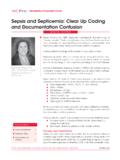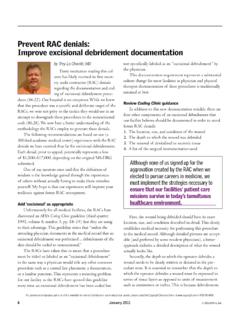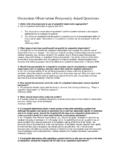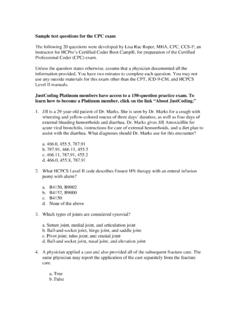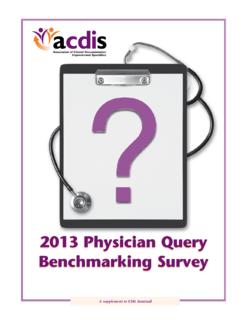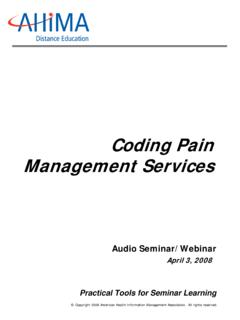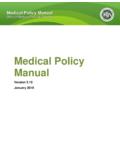Transcription of Coding Clinic update - HCPro
1 Coding Clinic update November 2011 Editor s note: The following article is provided as a supplement to the July 2011 CdI Journal. Note that this special supplement is not intended to replace or serve as a substitute to official guidance published in Coding Clinic . CDI specialists are strongly encouraged to obtain their own subscription to Coding Clinic for ICD-9-CM and to read and apply its advice in concert with their own Coding and compliance departments. Learn more about Coding Clinic for ICD-9-CM at CDI specialists, coders, Coding auditors/educators, and physician advisors. It s time to review the AHA Coding Clinic for ICD-9-CM, Second Quarter 2011, as we partner with physicians to clarify inconsistent, incom-plete, imprecise, conflicting, and illegible clinical documentation in the medical record and to apply ICD-9-CM Coding conventions and guidelines in a compliant manner.
2 This was a light issue for CDI specialists, as much of the published guidance pertained to straightforward issues. Nevertheless, there were a couple of impor-tant entries on acute renal failure (ARF) in the setting of end-stage renal disease (ESRD), the clinical significance regarding lysis of adhesions, and others entries for which physician education and compliant query updates may be needed. Let s take a look at what the AHA Central Office on ICD-9-CM had to procedure (p. 3)A reader inquired whether the concept of the principal procedure was important in code specialists should know that MS-DRGs are based on classifica-tions and terminology consistent with the ICD-9-CM and the Uniform Hospital Discharge Data Set (UHDDS), as recommended to the Secretary of the Department of Health and Human Services (HHS) by the National Committee on Vital and Health Statistics (Uniform Hospital Discharge Data: Minimum Data Set, National Center for Health Statistics, April 1980), revised in 1984 by the Health Information Policy Council of the HHS, and approved for use by the Secretary of HHS for use starting January 1986.
3 For those with access, the 1985 Federal Register (online access is only available to Federal Register publications after 1993), may be found at Coding Clinic updateEducate your providers to document clinical significance of proceduresWhite paper principal procedure 1 Conversion disorder with pseudoseizures 3 Medical marijuana 4 excisional debridement 4 Mediastinum tumor vs. goiter 5 arF and eSrD 6 Lysis of adhesions: Clarification 6 FeatUreSJames S. Kennedy, MD, CCS 2 Coding Clinic update November 2011 2011 by HCPro , inc. any reproduction is strictly prohibited. For more information, call 877/233-8734 or visit following UHDDS definitions are requirements of the ICD-9-CM Coding system and have been used as a standard for the development of DRGs: Diagnoses are defined to include all conditions that affect the cur-rent hospital stay.
4 Those that do not affect the current hospital stay are added only if required by hospital policy. The principal diagnosis is defined as the condition established after study to be chiefly responsible for occasioning the admission of the patient to the hospital for care. Other diagnoses (also called secondary diagnoses or additional diagnoses) are defined as all conditions that coexist at the time of admission, that develop subsequently, or that affect the treatment received or the length of stay or both. Diagnoses that relate to an earlier episode of care that have no bearing on the current hospital stay are excluded. All procedures performed will be reported. This includes those that are surgical in nature, carry a procedural risk, carry an anesthetic risk, or require specialized this entry, Coding Clinic emphasizes that the principal procedure is defined as a procedure performed for definitive treatment, rather than diagnostic or exploratory purposes, and/or is a procedure performed to treat a complica-tion.
5 This should not be a surprise to those familiar with Coding fundamen-tals; however, since neither the ICD-9-CM Official Guidelines for Coding and Reporting nor the ICD-10-PCS addresses the definition of principal proce-dure, I am glad that Coding Clinic covered this this advice does not state is that CMS believes the principal proce-dure must be related to the principal diagnosis, evidenced by the follow-ing statement in CMS report to Congress on Recovery Audit Contractors released in this fall and available at On p. 20, this report states:The principal diagnosis and principal procedure codes for an inpatient claim should be related. Errors occur when providers bill an incorrect principal and/or secondary diagnosis that results in an incorrect Medicare Severity Diagnosis-Related Group and CDI staff working in the hospital setting must pay special atten-tion to principal diagnosis and principal procedure assignment for the fol-lowing reasons: If the principal diagnosis is not related to any designated prin-cipal or secondary procedures, many DRG algorithms, such as MS-DRGs and 3M s APR-DRGs, group to the category Procedure not related to Principal Diagnosis, which, more often than not, has a higher relative weight than customarily attained for the pro-cedure.
6 Of course, these are more likely to be audited, thus they should be assigned with 2011 Coding Clinic update 3 2011 by HCPro , inc. any reproduction is strictly prohibited. For more information, call 877/233-8734 or visit If a patient has two significant reasons for inpatient admission and two significant surgical procedures are performed during a hospital admission, Medicare s surgical hierarchy may result in a surprising DRG assignment based on which diagnosis is assigned as the prin-cipal is best explained by an example. Consider a patient with known aortic stenosis who is being evaluated for an aortic valve replace-ment. Due to severe hyperkalemia found on the admitting labora-tory, the patient was admitted to lower the serum potassium level.
7 Rather than discharging the patient, the patient undergoes an aortic valve replacement and removal of a substernal goiter. See what hap-pens when , Hyperpotassemia, or , Aortic valve disorder, is sequenced as the principal diagnosis in the setting of procedure codes , Open and other replacement of the aortic valve, and , Complete substernal firmly believe that CDI specialists should learn how to use an encoder, especially in their preparation for ICD-10. If your facility hasn t granted CDI staff access to this important tool and resource, ask for it, learn how to use it, and do this in conjunction and cooperation with your HIM department Coding disorder with pseudoseizures (p. 5)In this entry, a patient is found after a psychiatric evaluation with pseu-doseizures in the setting of post-traumatic stress disorder and attention deficit hyperactivity disorder and after a neurological examination whereby a seizure disorder was ruled out.
8 Coding Clinic advised to assign code , Conversion disorder, as the principal diagnosis, with , Other convul-sion disorders, added as a secondary diagnosis. This advice may be controversial, given how the term pseudoseizure is listed in the ICD-9-CM Alphabetic Index of Diseases. Pseudoseizure non-psychiatric psychiatric that psychiatric pseudoseizure does not have an additional code for , Other convulsions, listed in the Index to Diseases. It appears to me that this pseudoseizure was psychiatric in nature, requiring only code to be entry also raises the issue of whether symptom codes (which, in this case, is , Other convulsions) routinely associated with their underlying condition should be coded. The ICD-9-CM Official Guidelines for Coding and Reporting states: 4 Coding Clinic update November 2011 2011 by HCPro , inc.
9 Any reproduction is strictly prohibited. For more information, call 877/233-8734 or visit and symptoms that are associated routinely with a disease process should not be assigned as additional codes, unless otherwise instructed by the may argue that a convulsion or seizure is integral to a psychiatric pseu-doseizure, given how it is listed in the Alphabetic Index to does this matter? While this advice does not affect MS-DRGs or Medicare s inpatient psychiatry prospective payment system, it does affect APR-DRGs. Note the following scenarios: Scenario 1: Principal diagnosis of psychiatric pseudoseizure alone; APR-DRG 880 Acute Anxiety and Delirium; SOI 1; relative weight of Scenario 2: Principal diagnosis of psychiatric pseudoseizure ( ) with a secondary diagnosis of seizure, ; APR-DRG 880 Acute Anxiety and Delirium; SOI 2; relative weight of this advice in relation to ICD-9-CM conventions and the ICD-9-CM Official Guidelines for Coding and Reporting when submitting these codes for potential inpatient marijuana (p.)
10 7)This entry states that when marijuana is prescribed by a physician for patient use, code , Nondependent abuse of drugs, cannabis abuse, is NOT assigned. Instead, (Long-term current use of other medi-cations) should be assigned, given that when marijuana is prescribed by a physician in accordance with state law and taken as directed, it is not considered an adverse effect occur due to overdosage or because prescribed marijuana was inappropriately administered, an appropriate poisoning code should be assigned. Consider Coding Clinic , 5th Issue 1994, p. 9, for further debridement (p. 11)In this scenario, a patient is diagnosed with necrotizing soft tissue abscess/infection of the buttock, which was surgically addressed. The provider s documentation included: A title of an excisional debridement of skin and subcutaneous tissue Description in the operative note of connection of the abscesses with incision, extensive excision of wound, and breaking and unroofing of smaller abscess cavitiesCoding Clinic tells us that this documentation is sufficient to assign pro-cedure code , Excisional debridement, and that the incisions of the wound would be considered integral to the excisional debridement.

